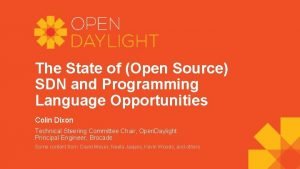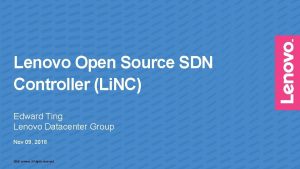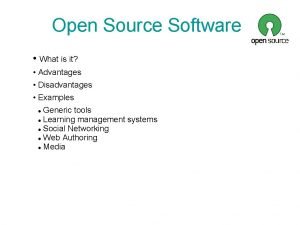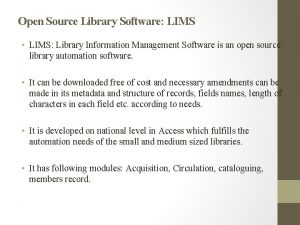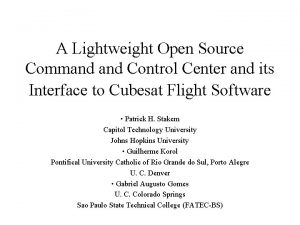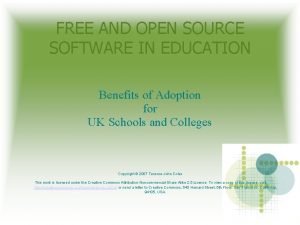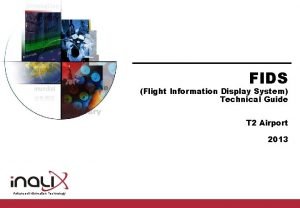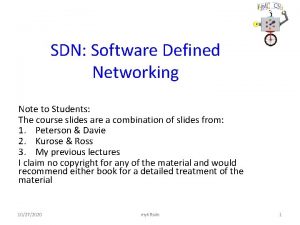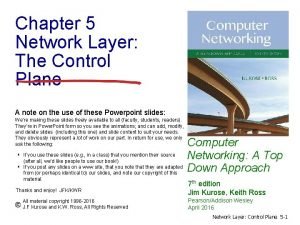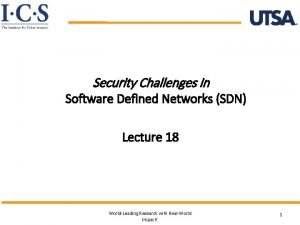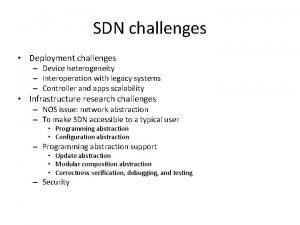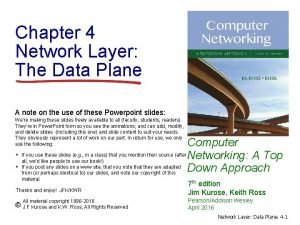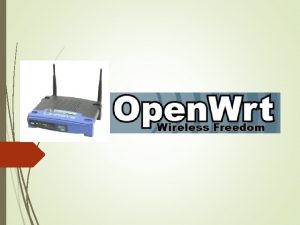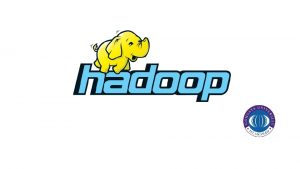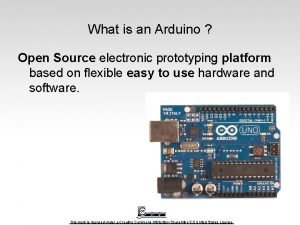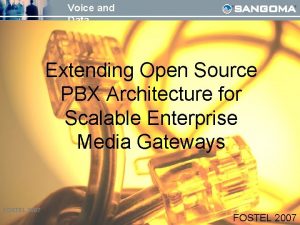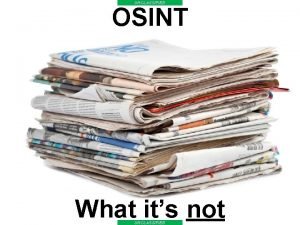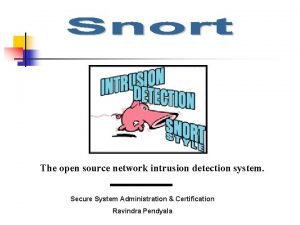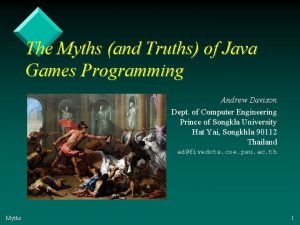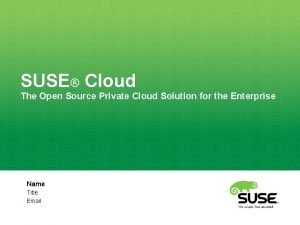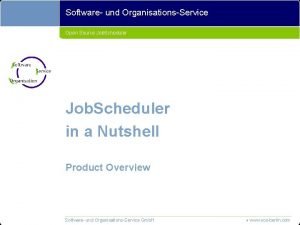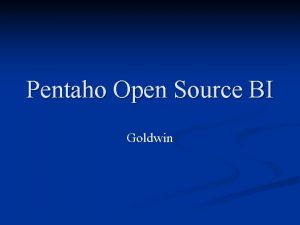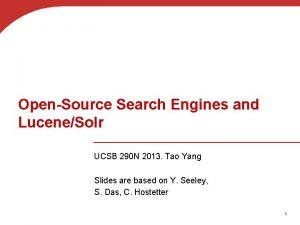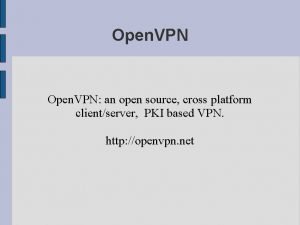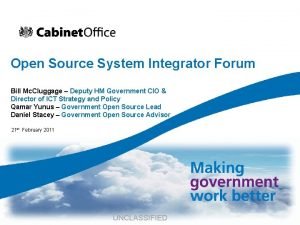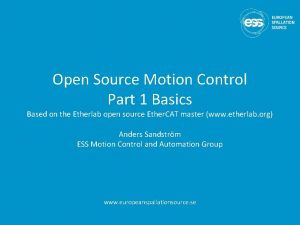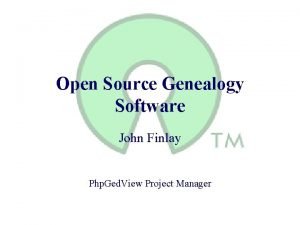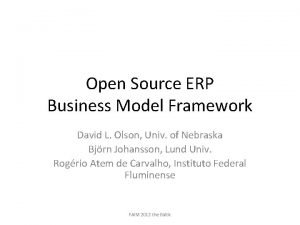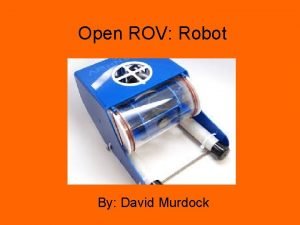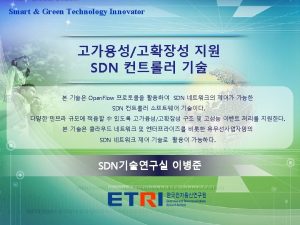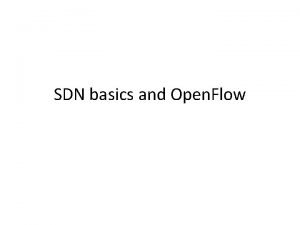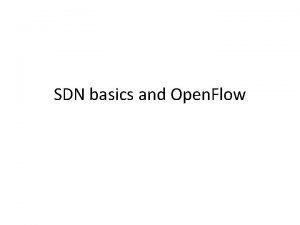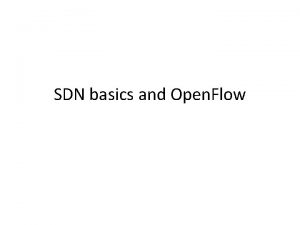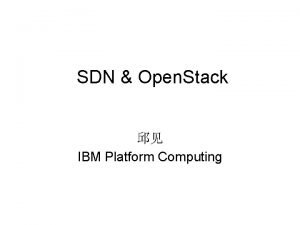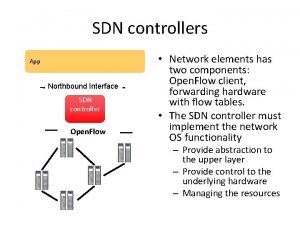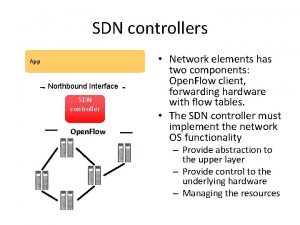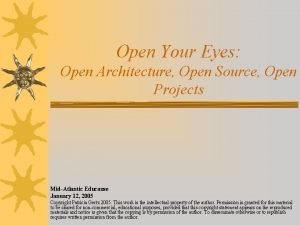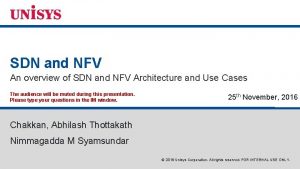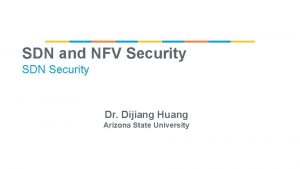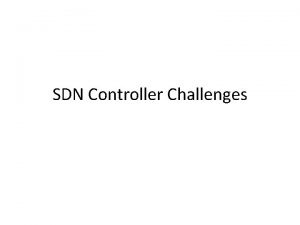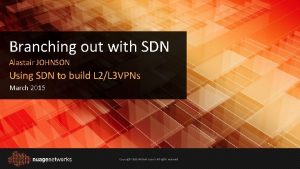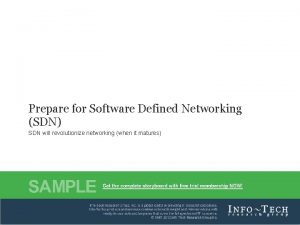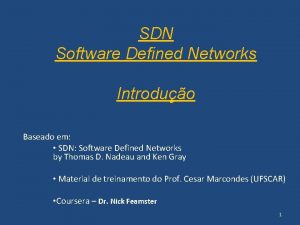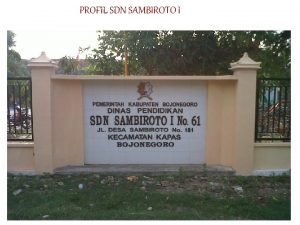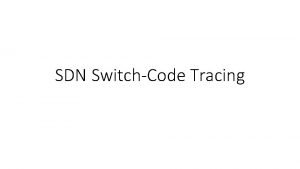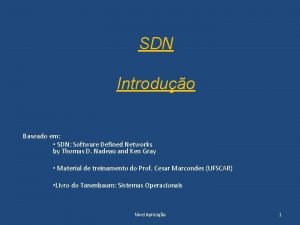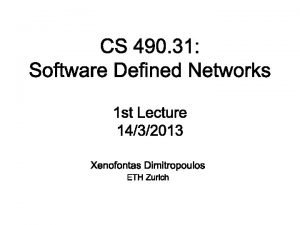The State of Open Source SDN and Programming







































- Slides: 39

The State of (Open Source) SDN and Programming Language Opportunities Colin Dixon Technical Steering Committee Chair, Open. Daylight Principal Engineer, Brocade Some content from: David Meyer, Neela Jaques, Kevin Woods, and others

Outline • What I know a lot about • Who I am and why I’m here • A brief history of SDN • Problems that I have • What I know a lot less about • Ideas for how to solve them in “nice” ways • …instead of my normal systemsy hacks

Colin Dixon • Ph. D Univ. of Washington 2011 • IBM Research Austin 2012– 14 • Started with ODL in late 2012 • Open. Daylight 2012 -present • Committer-at-Large (9/2014) • TSC Chair (10/2014) • Brocade 2014 -present • Grad Student • Research Lab Academic • Working on products • Working in Open Source • Industry • Working in Open Source • Shipping products

A brief history of SDN • Original Papers • 4 D (2004/2005) • SANE/Ethane (2006/2007) • Open. Flow (2008) • Onix (2010) explosion This is just Controllers • (Open Source) Software • Open v. Switch (2009) • NOX/POX (2009/2011) • Beacon (2010) • Trema (2011) • Floodlight (2011/2012) • Ryu (2011/2012) • Open. Daylight (2013) • ONOS (2014)

Traditional SDN (Open. Flow) Install table entry, send packet The separation of the control and data planes SDN Controller • Modern switches • Control/data plane both on switch • Data plane: fast, reads tables • Control plane: slow, writes tables • SDN • Decouple control/data planes • Data plane on the switch • Control plane elsewhere, e. g. , an x 86 server, can do fancier things Most features go here This gets smaller, turns into controller to switch chip translator Control Plane CPU Switch Chip 0 A->0 C 0 A->0 E Ports, 1 -6 0 C->4 Table miss, send to controller dst port 0 E 6 0 A 1 0 C 4

Modern, Inclusive SDN Vendor A Vendor B Vendor C NETCONF/YANG Northbound API Logically Centralized SDN Controller Industry Standard Control/Management Protocols Standard mgmt mgmt Modeling control control Vendor A Vendor B Vendor C Language

Acquisitions (very incomplete) • 2012: Nicira => VMware (1. 26 B) • 2012: Contrail => Juniper (176 M) • 2013: Insieme => Cisco (863 M) • 2014: Tail-F => Cisco (175 M) • 2015: Cyan => Ciena (400 M)

Deployed in Production Today • AT&T’s Domain 2. 0 initiative • Broad attempt to move to SDN and NFV in a major way • BWo. D runs us Brocade’s Open. Daylight-based controller • Also see: • Google, Microsoft, VMware, etc.

Summary • SDN has gone from wild, crazy academic idea to reality • Tons of attention from academia and industry • Sustained ~1 B/year in acquisitions • Along the way it’s changed a lot • Not just about separation of the control plane from the data plane • Not just Open. Flow • I think it’s the rise of open source software networking

Open Source SDN Projects of Note • Akanda • Cloud. Router • Mido. Net • ONIE • ONOS • OVN • Open Compute • Open Network Linux Orchestration Management/ Control/ Data Open Network Linux • Open. Contrail • Prescriptive Topology Manager • Quagga • Socket. Plane • Weave • …and many, many more

What is Open. Daylight is an Open Source Software project under the Linux Foundation with the goal of furthering the adoption and innovation of Software Defined Networking (SDN) through the creation of a common industry supported platform. Code Acceptance Community To create a robust, extensible, open source code base that covers the major common components required to build an SDN solution To get broad industry acceptance amongst vendors and users: • Using it directly or through vendor products • Vendors using Open. Daylight in commercial products To have a thriving and growing technical community contributing to the code base, using the code in commercial products, and adding value above, below and around.

Open. Daylight Releases • Hydrogen (first release) • February 2014 • 13 projects, 1. 3 m lines of code • Helium • October 2014 • 25 projects, 2. 1 m lines of code • Lithium (most recent release) • June 2015 • 40 projects, 2. 3 m lines of code

Core Architecture App/Servi ce Model-Driven Service Abstraction Layer (MD-SAL) Plugin Controllers in a Cluster Notifications RPCs Data Plugin YANG Models

What does YANG data look like • container ~= struct • list ~= map/dictionary • leaf ~= primitive types • grouping ~= interface grouping node-attributes { leaf node-id {. . . } } container network-topology { list topology { key "topology-id"; leaf topology-id { type topology-id; } list node { key "node-id"; uses node-attributes; } • Others: typedef, pointers, constraints, etc. } } list link { key "link-id"; uses link-attributes; }

Why Java? • Obvious answer: it’s what we started in, so… • Slightly deeper: • ~40 companies looking to hire ~10 developers each at some cost • Java developers are (a) common, (b) reasonably priced, (c) somewhat safe • CUDA/Open. CL : GPUs : : Open. Daylight : Java programmers • Would we change to something else? • Not everywhere. In some places, maybe.

Programming Language Opportunities Things that are currently causing me problems.

SDN Grand Challenges • Centralized vs. Distributed • RAFT distributed consensus algorithm in Helium • Continued work on clustering in Lithium and beyond • Migration to SDN • Support SNMP, BGP, LISP, NETCONF “legacy” protocols • Application Composition • Support for declarative, intentbased policy • Unified models for inventory, topology, and more • Hardware Diversity • Support for Table Type Patterns • Device Driver Framework provides adaptation in Lithium

How to get there from here • How do we deploy SDN when it’s not green field • Because pretty much nothing is actually green field • Hybrid switches, hybrid networks, legacy protocols for interoperability, etc. • Open. Daylight supports SNMP, BGP, LISP, NETCONF, etc. • Trust and stability • Current networks build on 40 years of code/experience • How can SDN compete with that? • Borrow good code/ideas from legacy code • Provide better visibility, debugging, etc. • Model checking, verification, etc. 18

How to get there from here • Flowlog’s Exodus, Header Space Analysis, etc. MB • Translate legacy config to SDN programs with correct semantics OF SDN OF OF Loop? Connected? Unreachable? • Works pretty well when everything is “SDN-enabled” • In practice, connected to legacy network devices • Also, middleboxes

Centralized vs. Distributed (Consistency, Clustering and Federation) • SDN promises a (logically) centralized control plane • In practice, we have a distributed cluster of controllers, rather than just one so that • we can tolerate faults • we can scale out our performance • in network partitions there are controllers on both sides • Providing consistency, federation, scale-out, dealing with CAP trade-offs, etc. is HARD http: //events. linuxfoundation. org/sites/events/files/slides/sdn-consistency-ods 2014. pdf https: //www. youtube. com/watch? v=XQ-ln. B 3 x 30 g

Centralized vs. Distributed (Consistency, Clustering and Federation) • What properties can I provide when mixing consistency levels? • the topology is stored in an eventually consistent manner • the actions I take based on it should not diverge • Is Irmin one answer?

Hardware Diversity • Open. Flow 1. 0 provided a lowest common denominator API • Real hardware is much more diverse • and has many more capabilities • Exposing this diversity without burdening developers with per-device programming is hard • Some Attempts • Programming Protocol-independent Packet Processors (P 4) • TTPs from the ONF’s FAWG https: //www. youtube. com/watch? v=bca. BS 6 w_k_o http: //events. linuxfoundation. org/sites/events/files/slides/TTPs%20 and%20 NBIs%20 for%20 ods 2014 -final_0. pdf http: //arxiv. org/pdf/1312. 1719 v 1. pdf 22

Table Type Patterns • Really just a simple way to express fixed OF 1. 3 pipelines • DAG of tables • Legal jumps between tables • Legal matches in each table • Legal actions/instructions in each table • Hope is to be able to map SDN services/apps to these in a sane way • Compiler? What’s the source language?

Are TTPs also the source language? L 2 Forwarding DMAC => port Broadcom OF-DPA 10 -table TTP L 2/L 3 Fwding/Routing DMAC=>port IP=>nxt. Hop=>port Netronome Corsa Marvell Soon: HP, Dell, Intel…

Why is this hard? cont • Some actions are impossible on a given switch VNF • Can “fake” it in the controller • Better: use a fast programmable software switch • Could even be an end-host v. Switch, host stack, NIC OF SDN OF OF

Application Composition • How can we let multiple SDN apps share the network? • PC OSes partition and allocate resources • We’re systems people, we can’t help it! You can’t easily partition the network • It’s value comes from the fact that it spans everything • You can in some cases, e. g. , by address space (Flow. Visor) • Some ideas • Most apps should be middleboxes, i. e. , NFV Better Idea: DSLs? • Simply chain them together in the right order • There’s more to it than this, but linear chaining is powerful Have: Neutron, NIC, GBP • Other apps are concerned only with the physical path • There is hope that conflicts here can be sanely managed Coming to ODL: NEMO, Maple, Pyretic 26

Application Composition • The reality in Open. Daylight • Some apps written to h/w • Other apps written to DSLs • Many different DSLs • Can I combine different DSLs? • What about detecting conflicts with apps with no properties? App 2 App 1 App 3 DSL 2 comp. DSL 3 composition Controller flows on switches App 4

Call to Action

Open source => real impact quickly • If you have ideas, they can be real pretty quickly • Switches: OF-DPA + Open Network Linux on Broadcom Hardware • Controllers: Open. Daylight, ONOS, etc. • Orchestration: Open. Stack, etc. • You don’t have to play with simulators • Build the real thing in real code that real people can pick up and use

Open. Daylight in particular • Designed to be customized and productized • Ridiculously modular • Nobody will tell you no (at least to producing a new project) • We could really use help, guidance and people.

Backup Slides

Network-wide Security Policy • Historically, policy is mostly • Rigidly enforced by the physical topology, e. g. , firewall at the gateway • Configured “dynamically” via box-by-box Access Control Lists (ACLs) • New policy efforts are changing this • Network Function Virtualization (NFV) and Service Function Chaining (SFC) • Automatically generated ACLs based on network-wide policy • Open. Daylight is a proving ground for at least 3 policy-oriented projects • Service Function Chaining, Group-Based Policy, and Network Intent Composition

Open. Stack Neutron Integration • Open. Daylight has a common Neutron “northbound” provider Open. Stack Neutron ML 2 Mechanism. Driver • 3 implementations in Helium • 4+ implementations in Lithium Open. Daylight APIs (REST) • Supports L 2 network virtualization and Neutron Service VTN Provider Open. Contrail Provider Open. Daylight OVSDB Provider • Distributed L 3 forwarding • Security Groups • {LB, VPN}aa. S

Programmable EMS and/or NMS • Huge number of southbound protocol drivers • Open. Flow, NETCONF, OVSDB, SNMP, BGP, PCEP, PCMM/COPS, etc. • With a little bit of effort, you can write “shell scripts” for your network to either gather information or automate tasks • Automate triggering activities based on network events, e. g. , quarantine a host with L 2 ACLs based on information from an IDS

How can I get it? • Open. Daylight: http: //www. opendaylight. org/software/downloads • Also commercialized, supported versions from • Brocade, Ciena, Cisco, Inocybe, and others • Understand the difference between “uses” and “based on” Open. Daylight • Policy on “upstreaming” changes and compatibility with other products • The Brocade Vyatta Controller is based on unmodified Open. Daylight and upstreams all changes to Open. Daylight • Get it here: https: //tinyurl. com/Brcd. Vyta. Cntrlr


Who is Open. Daylight?

Who is Open. Daylight? (Really)

Who is Open. Daylight? (Really) • Like any Open Source Project, Open. Daylight primarily consists of those who show up to do the work. • Running around 300 commits per week over 12 months, trending up • 30 Days: ~3200 commits, ~150 contributors (4/1/15– 5/1/15; during a release) • 12 Months: ~16, 000 commits, ~325 contributors (5/1/14– 5/1/15) • Strong integration and testing community • This stuff really matters Source: https: //www. openhub. net/p/opendaylight
 Open source sdn software
Open source sdn software Lenovo thinksystem ne2552e flex switch
Lenovo thinksystem ne2552e flex switch Open innovation open science open to the world
Open innovation open science open to the world Perbedaan linear programming dan integer programming
Perbedaan linear programming dan integer programming Greedy vs dynamic programming
Greedy vs dynamic programming What is system program
What is system program Linear vs integer programming
Linear vs integer programming Programing adalah
Programing adalah Advantages and disadvantages of using open source software
Advantages and disadvantages of using open source software Lims library software
Lims library software Module 4 - open source software and licensing
Module 4 - open source software and licensing Open source command and control software
Open source command and control software Benefits of free software
Benefits of free software Flight information display system and open source
Flight information display system and open source Sdn vs traditional networking
Sdn vs traditional networking Examples of sdn
Examples of sdn Generalized forwarding and sdn
Generalized forwarding and sdn Sdn security challenges
Sdn security challenges Sdn issues and challenges
Sdn issues and challenges Generalized forwarding and sdn
Generalized forwarding and sdn Wrt open
Wrt open Hadoop is open source
Hadoop is open source Open source electronics prototyping platform
Open source electronics prototyping platform Open source pbx
Open source pbx Nato osint handbook
Nato osint handbook Intrusion detection open source
Intrusion detection open source Java games programming
Java games programming Private suse repository
Private suse repository Job scheduler open source
Job scheduler open source Pentaho open source
Pentaho open source I/o device management in operating system
I/o device management in operating system Open source search engines
Open source search engines Open source vpn client
Open source vpn client Sipfoundry
Sipfoundry Open source software integrator
Open source software integrator Open source motion control
Open source motion control Genealogy software open source
Genealogy software open source Open source erp framework
Open source erp framework Open source nonprofit crm
Open source nonprofit crm Podu robotics
Podu robotics
